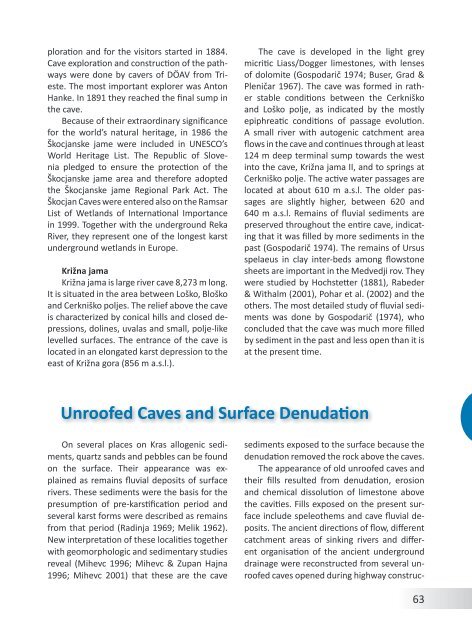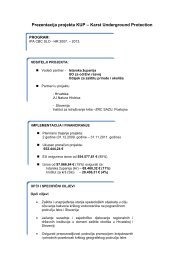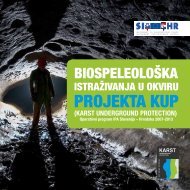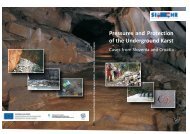ploration and for <strong>the</strong> visitors started in 1884.Cave exploration and construction <strong>of</strong> <strong>the</strong> pathwayswere done by cavers <strong>of</strong> DÖAV <strong>from</strong> Trieste.The most important explorer was AntonHanke. In 1891 <strong>the</strong>y reached <strong>the</strong> final sump in<strong>the</strong> cave.Because <strong>of</strong> <strong>the</strong>ir extraordinary significancefor <strong>the</strong> world’s natural heritage, in 1986 <strong>the</strong>Škocjanske jame were included in UNESCO’sWorld Heritage List. The Republic <strong>of</strong> <strong>Slovenia</strong>pledged to ensure <strong>the</strong> protection <strong>of</strong> <strong>the</strong>Škocjanske jame area and <strong>the</strong>refore adopted<strong>the</strong> Škocjanske jame Regional Park Act. TheŠkocjan Caves were entered also on <strong>the</strong> RamsarList <strong>of</strong> Wetlands <strong>of</strong> International Importancein 1999. Toge<strong>the</strong>r with <strong>the</strong> underground RekaRiver, <strong>the</strong>y represent one <strong>of</strong> <strong>the</strong> longest karstunderground wetlands in Europe.Križna jamaKrižna jama is large river cave 8,273 m long.It is situated in <strong>the</strong> area between Loško, Bloškoand Cerkniško poljes. The relief above <strong>the</strong> caveis characterized by conical hills and closed depressions,dolines, uvalas and small, polje-likelevelled surfaces. The entrance <strong>of</strong> <strong>the</strong> cave islocated in an elongated karst depression to <strong>the</strong>east <strong>of</strong> Križna gora (856 m a.s.l.).The cave is developed in <strong>the</strong> light greymicritic Liass/Dogger limestones, with lenses<strong>of</strong> dolomite (Gospodarič 1974; Buser, Grad &Pleničar 1967). The cave was formed in ra<strong>the</strong>rstable conditions between <strong>the</strong> Cerkniškoand Loško polje, as indicated by <strong>the</strong> mostlyepiphreatic conditions <strong>of</strong> passage evolution.A small river with autogenic catchment areaflows in <strong>the</strong> cave and continues through at least124 m deep terminal sump towards <strong>the</strong> westinto <strong>the</strong> cave, Križna jama II, and to springs atCerkniško polje. The active water passages arelocated at about 610 m a.s.l. The older passagesare slightly higher, between 620 and640 m a.s.l. Remains <strong>of</strong> fluvial sediments arepreserved throughout <strong>the</strong> entire cave, indicatingthat it was filled by more sediments in <strong>the</strong>past (Gospodarič 1974). The remains <strong>of</strong> Ursusspelaeus in clay inter-beds among flowstonesheets are important in <strong>the</strong> Medvedji rov. Theywere studied by Hochstetter (1881), Rabeder& Withalm (2001), Pohar et al. (2002) and <strong>the</strong>o<strong>the</strong>rs. The most detailed study <strong>of</strong> fluvial sedimentswas done by Gospodarič (1974), whoconcluded that <strong>the</strong> cave was much more filledby sediment in <strong>the</strong> past and less open than it isat <strong>the</strong> present time.Unro<strong>of</strong>ed Caves and Surface DenudationOn several places on Kras allogenic sediments,quartz sands and pebbles can be foundon <strong>the</strong> surface. Their appearance was explainedas remains fluvial deposits <strong>of</strong> surfacerivers. These sediments were <strong>the</strong> basis for <strong>the</strong>presumption <strong>of</strong> pre-karstification period andseveral karst forms were described as remains<strong>from</strong> that period (Radinja 1969; Melik 1962).New interpretation <strong>of</strong> <strong>the</strong>se localities toge<strong>the</strong>rwith geomorphologic and sedimentary studiesreveal (Mihevc 1996; Mihevc & Zupan Hajna1996; Mihevc 2001) that <strong>the</strong>se are <strong>the</strong> cavesediments exposed to <strong>the</strong> surface because <strong>the</strong>denudation removed <strong>the</strong> rock above <strong>the</strong> caves.The appearance <strong>of</strong> old unro<strong>of</strong>ed caves and<strong>the</strong>ir fills resulted <strong>from</strong> denudation, erosionand chemical dissolution <strong>of</strong> limestone above<strong>the</strong> cavities. Fills exposed on <strong>the</strong> present surfaceinclude speleo<strong>the</strong>ms and cave fluvial deposits.The ancient directions <strong>of</strong> flow, differentcatchment areas <strong>of</strong> sinking rivers and differentorganisation <strong>of</strong> <strong>the</strong> ancient undergrounddrainage were reconstructed <strong>from</strong> several unro<strong>of</strong>edcaves opened during highway construc-63
tion in <strong>the</strong> Divaški kras (Mihevc 1996; Mihevc& Zupan Hajna 1996). The thickness <strong>of</strong> rockoverburden removed above cavities was establishedto have been 50–100 m. The age <strong>of</strong>cave fills was calculated <strong>from</strong> denudation ratesand <strong>the</strong> expected thickness <strong>of</strong> missing overburdento 0.7–5 Ma (Mihevc 1996, 2001). Thislarge time range resulted <strong>from</strong> <strong>the</strong> expectedminimum (20 m/Ma) and maximum denudationrates (50 m/Ma) calculated or measuredin <strong>the</strong> area (Gams 1962; Cucchi et al. 1994).Unro<strong>of</strong>ed caves were also described by Šebela& Mihevc (1995), Šebela (1995, 1999), Mihevc,Slabe & Šebela (1998), Šušteršič (1998), Knez& Slabe (1999a, b).The study (Zupan Hajna et al. 2008a) <strong>of</strong>cave deposits in unro<strong>of</strong>ed caves <strong>of</strong> <strong>the</strong> Krasprovided entirely new insights into <strong>the</strong> age <strong>of</strong>cave and karst sediments and introduced newideas concerning <strong>the</strong> development <strong>of</strong> karst.Geomorphic comparative method used fordating <strong>of</strong> processes and landforms showedthat many accessible caves in <strong>the</strong> Kras are <strong>of</strong>Pliocene age at least or even older (Mihevc1996, 2000, 2001).The shape <strong>of</strong> unro<strong>of</strong>ed caves depends on(1) <strong>the</strong> morphology <strong>of</strong> <strong>the</strong> present surface; (2)size, type and original arrangement <strong>of</strong> caves,and (3) <strong>the</strong> cave fill. Unro<strong>of</strong>ed caves are usuallyaltered by surface processes. They representan important element <strong>of</strong> <strong>the</strong> epikarst zone. On<strong>the</strong> surface, <strong>the</strong>y are expressed as narrow and<strong>of</strong>ten meandering shallow trenches, shallowoblong depressions, doline-like forms in rowsand collapsed dolines. Mihevc (1999a) <strong>of</strong>feredmodels <strong>of</strong> <strong>the</strong>ir origin and <strong>the</strong>ir relation to <strong>the</strong>presently accessible caves.Lipove dolineUnro<strong>of</strong>ed caves are an important part <strong>of</strong><strong>the</strong> surface morphology <strong>of</strong> Divaški kras where2,900 m <strong>of</strong> <strong>the</strong> unro<strong>of</strong>ed caves were mapped(Mihevc 2001). In such features, flowstone,allochtonous sediments and morphology aretestifying <strong>the</strong>ir cave origin. The proportion <strong>of</strong>denuded caves is small in area (only approximately0.16 % <strong>of</strong> <strong>the</strong> total area). The largestsuch denuded or unro<strong>of</strong>ed cave <strong>of</strong> <strong>the</strong> Divaškikras is located on <strong>the</strong> surface nor<strong>the</strong>ast <strong>of</strong>Škocjanske jame, named after great number <strong>of</strong>dolines Lipove doline. The mapping <strong>of</strong> <strong>the</strong> surfaceshowed a 1800-m long series <strong>of</strong> dolinesand elongated dolina-like depressions 450 mabove sea level and interconnected withouthigher thresholds. The bottoms <strong>of</strong> <strong>the</strong> dolinesare 5 m to 10 m below <strong>the</strong> level <strong>of</strong> <strong>the</strong> rest <strong>of</strong><strong>the</strong> surface; <strong>the</strong> depressions are 20 m to 30 mwide. Chert pebbles, yellowish red sandy loamand massive flowstone were found at <strong>the</strong> bottom<strong>of</strong> <strong>the</strong> dolines. The denuded cave passageforks in a number <strong>of</strong> places. In <strong>the</strong> westernpart <strong>of</strong> this ro<strong>of</strong>less cave, in one <strong>of</strong> <strong>the</strong> Lipovedolines, quartz sand was exploited, duringwhich a large amount <strong>of</strong> flowstone and a largestalagmite were exposed. The stalagmite and<strong>the</strong> sediments were first described by Pleničar(1954), who interpreted <strong>the</strong> cave as small cavewith a collapsed ro<strong>of</strong> located near <strong>the</strong> surface.The unro<strong>of</strong>ed cave in Lipove doline is similarto Škocjanske jame in its dimensions, as <strong>the</strong>width <strong>of</strong> <strong>the</strong> tunnel was in some places likelyto be more than 20 m. Anticipation <strong>from</strong> <strong>the</strong>massive stalagmite, <strong>the</strong> ceiling <strong>of</strong> <strong>the</strong> cave wasat least 10 m thick and at least 500 m abovesea level during <strong>the</strong> time when flowstone wasdeposited.The unro<strong>of</strong>ed cave Ulica and Ulica pečinacaveThe unro<strong>of</strong>ed cave Ulica and Ulica pečinacave (Fig. 46) are situated in <strong>the</strong> sou<strong>the</strong>astpart <strong>of</strong> <strong>the</strong> Matarsko podolje (SW <strong>Slovenia</strong>),near <strong>the</strong> Croatian border. They are presumablyremains <strong>of</strong> <strong>the</strong> same cave system as Račiškapečina (Mihevc 2004). The passages <strong>of</strong> Račiškapečina are in elevation between 598-589 m.The 1,200 m distant Ulica pečina cave has itsparagenetic ceiling in elevation 585-589 m,while sediments at <strong>the</strong> bottom <strong>of</strong> <strong>the</strong> passageare between 585-562 m. In similar height, 580-585 m, is also <strong>the</strong> floor <strong>of</strong> <strong>the</strong> unro<strong>of</strong>ed caveUlica.64
- Page 2 and 3:
Andrej Mihevc, Mitja Prelovšek, Na
- Page 4 and 5:
ContentsGeographical Position and G
- Page 7 and 8:
Fig. 2: Coastal part of Dinaric kar
- Page 9 and 10:
ogy started. In 1531 a lawyer from
- Page 11 and 12: include numerous data and general o
- Page 13 and 14: GeologyNadja Zupan HajnaThe Dinaric
- Page 15 and 16: ceous. The final disintegration of
- Page 17 and 18: Fig. 11: Locations of Jelar Breccia
- Page 19 and 20: ClimateMitja PrelovšekThe Dinaric
- Page 21 and 22: 311 mm/a; Zaninović 2008) and incr
- Page 23 and 24: 24Fig. 16: Spatial distribution of
- Page 25 and 26: ocks (such as Eocene flysch, Lower
- Page 27 and 28: absent. Downstreamparts of the cany
- Page 29 and 30: GeomorphologyAndrej MihevcIn folk l
- Page 31 and 32: long. They are smoother especially
- Page 33 and 34: is now depositing. Best known are t
- Page 35 and 36: Structural poljes are dominated by
- Page 37 and 38: Fig. 28: Typical dolines of Dinaric
- Page 39 and 40: the disintegrated collapsed rock at
- Page 41 and 42: on Northern Velebit, where three ca
- Page 43 and 44: Land UseNadja Zupan Hajna, Andrej M
- Page 45 and 46: for ‘bare limestone desert’ -th
- Page 47 and 48: Fig. 38: Grančarevo dam in the upp
- Page 49 and 50: KrasThe Kras is a distinct plateau,
- Page 51 and 52: in this part of the Kras (Mihevc 20
- Page 53 and 54: dolomite barrier along the Idrija w
- Page 55 and 56: of Dolenjska (Gams, 1974; Kranjc, 1
- Page 57 and 58: Fig. 44: Blind valleys of Matarsko
- Page 59 and 60: ly several dozen meters deep. Shaft
- Page 61: smaller than the higher ones. The r
- Page 65 and 66: Use of Karst and its ProtectionThe
- Page 67 and 68: Gams, I., Vrišer, I. (Eds.), 1998:
- Page 69 and 70: lems.- Dela 38, Raziskovalni center










